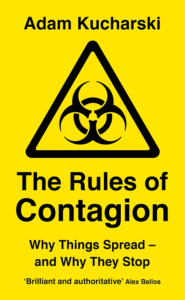This timely book by an epidemiologist gives fascinating insights into how things spread — not just viruses but ideas and misinformation too
The Covid-19 pandemic has brought focus on three fields of studies — epidemiology, virology and immunology. While all three are important to understanding the outbreak, the field that was shown most of the time in news was epidemiology — the science of spread and control of the disease.
The obvious reason for that is the nature of the field, which involves mathematical modelling and theories that scientists have drawn from diverse disciplines where things spread like financial contagion, fake news spread, habits and so on. Epidemiology influences politics more than the other two.
Adam Kucharski, an epidemiologist at the London School of Hygiene and Tropical Medicine, has come up with a book about this topic, The Rules of Contagion. While it is for obvious reasons a timely publication, its importance lies in how it explains complex topics in a simple, eloquent manner.
The book is divided into eight detailed chapters explaining things with brilliant anecdotes — from Ronald Ross’s story about how he studied malaria outbreaks to the 2008 financial crisis and about outbreaks of violence in society — Kucharski attempts to address all those things that spread with his own sense of understanding.
Sometimes, it is hard to catch up with Kucharski’s ideas when he jumps from one topic to another — he doesn’t care to finish a topic by giving his own answers, he leaves them as they are. Still, Kucharski’s style never lets a reader lose interest, as he holds their attention by narrating catchy stories of academic research in each chapter.
Kucharski thinks that there are similarities between disease outbreaks and violence too and epidemiology can be applied to understand violence because “just like an infection, violence can have an incubation period”.
He mentions Charlotte Watts, who in mid-1990s worked with the World Health Organisation (WHO) to set up a major study of domestic violence against women. “Watts had trained as a mathematician before moving into disease research, focusing on HIV. As her work on HIV developed, she started to notice that violence against women was influencing disease transmission because it affected their ability to have safe sex,” Kucharski writes.
Copycat suicides are another disease which spreads, though not to a great extent. Kucharski also pointed to social contagion and what follows the “aftermath of high-profile suicide”. “Researcher in Columbia University noted a 10 percent rise in months following the death of comedian Robin Williams. They pointed to a potential contagion effect, given that many reports after Williams’ did not follow WHO guidelines. Largest death was observed in middle-aged men using identical method.”
One of the interesting things that he addresses in a few chapters is of misunderstanding and misrepresenting some infection. One most important example he gave was of Canadian flight attendant Gaetan Dugas, who died of AIDS. Journalist Randy Shilts featured him in his book And the Band Played on, dubbing Dugas as patient zero. That grabbed a lot of attention but in 2016, a team of researchers found no evidence of Dugas being patient zero. He was just another case.
The stigma and segregation triggered an “us vs them” debate on who spread the infection is an important feature during a pandemic. The 1918 influenza pandemic is still known as “Spanish Flu” and this name emerged when a lot of media reports in Europe
blamed Spain for the virus. “These reports weren’t quite what they seemed,” as Spain had no media censorship at that time. Interestingly Spanish media blamed the French for the virus. During the Coronavirus outbreak too, many dubbed Covid-19 virus as Chinese.

The main protagonist of the book Ronald Ross’s stories around his studies to understanding malarial transmission are fascinating. Kocharski discussed his discoveries and background stories with a lot of interest from Ross’s idea of controlling the number of mosquitoes for controlling malaria to his fear that somebody would pirate his work, all that make this book interesting.
The media always has a fancy for concise and yet counter- intuitive insights. “They encounter ‘one simple idea’ that can explain everything.” Not just media, people in general think in the same way. In reality, things are so complicated and varied that one simple idea can’t explain it all.
Kocharski gives an example of Nyhan and Reifler, who studied the backfire effect. “During 2004 Democrats spread Bush has banned stem cell research while in reality, he just limited funding to certain aspects.” Even when Nyhan and Reifler corrected the belief among liberals, “the information was ignored but never backfired”.
Kucharski’s book is very relevant in the time we are living when outbreaks of disease, misinformation, habits and ideas appear in a flash and then disappear. There are rules for every contagion that are needed to be dug out and made clutter free. Kucharskis’ book does that for you.
(Cover: Adam Kucharski is an associate professor at the London School of Hygiene and Tropical Medicine, where he works on the analysis of infectious disease outbreaks // Photo: elpais.com )





